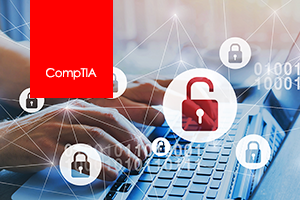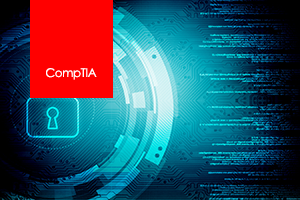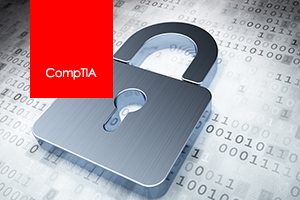
28 Hours |
|
89 Course Videos |
|
250 Test Questions |
This course provides advanced-level training in risk management, enterprise security operations and architecture, research and collaboration, and integration of enterprise security. It covers all of the new exam objectives for the CAS-003 exam. The CASP certification is the highest-level security certification offered by CompTIA and is the final step in achieving the new CompTIA Security Analytics Expert (CSAE) or Security Infrastructure Expert (CSIE) stackable certification.
In this course you will advance your skills in the following areas:
- Risk Management
- Enterprise Security Architecture
- Enterprise Security Operations
- Technical Integration of Enterprise Security
- Research, Development and Collaboration
This course is intended for advanced students and cybersecurity practitioners who will implement cybersecurity. Successful completion of pre-requisite courses in Security+ and CySA+/PenTest+ is highly recommended.
- 1. Intro CASP
- 2. CASP Introduction
- 3. Mod 1.1 Exploring Cloud Services Act
- 4. Mod 1.1 Acquisition Merger Demerger
- 5. Mod 1.1 Acquisition Merger Demerger Part2
- 6. Mod 1.2 Compare and Contrast
- 7. Mod 1.3 Given Scenario Execute Risk
- 8. Mod 1.3 Given Scenario Execute Risk Part2
- 9. Mod 1.3 Continuing Terminology IT Governance
- 10. Mod 1.4 Analyze Security Solution Metrics and Attributes
- 11. Mod 1.4 Analyze Risk
- 12. Mod 1.4 Trend Analysis Act
- 1. Mod 2 Enterprise Security Architecture
- 2. Mod 2.1 Network Device Security Act
- 3. Mod 2.1 Application and Protocol
- 4. Mod 2.1 Advanced Network Security Act
- 5. Mod 2.1 Complex Network Security Solution
- 6. Mod 2.1 Implementing VLANs Switchport Sec Act
- 7. Mod 2.1 Implementing VLANs Switchport Sec Act Part2
- 8. Mod 2.1 Distributed Denial of Service
- 9. Mod 2.1 Exploring DoS Attacks Act
- 10. Mod 2.1 Security Zones
- 11. Mod 2.1 Network Access Control
- 12. Mod 2.1 Searching for Vulnerablie ICS-SCADA Act
- 13. Mod 2.2 Analyze a Scenario Integrate Security
- 14. Mod 2.2 Configuring Windows Firewall Act
- 15. Mod 2.2 Log Monitoring and Auditing
- 16. Mod 2.2 Group Policy Act
- 17. Mod 2.2 Patch Management
- 18. Mod 2.2 Management Interface
- 19. Mod 2.2 Measured Launch
- 20. Mod 2.3 Analyze a Scenario to Integrate Security Controls
- 21. Mod 2.3 Security Implications Privacy
- 22. Mod 2.3 Baseband
- 23. Mod 2.4 Given Software Vulnerabilty Scenarios
- 24. Mod 2.4 SQL Injection Act
- 25. Mod 2.4 Improper Error and Exception Handling
- 26. Mod 2.4 Buffer Overflows Act
- 27. Mod 2.4 Memory Leaks
- 28. Mod 2.4 Researching Vulnerabilities Exploits Act-
- 1. Mod 3 Enterprise Security Operations
- 2. Mod 3 Runtime Debugging
- 3. Mod 3.1 Fingerprinting an OS Services Act
- 4. Mod 3.1 Code Review
- 5. Mod 3.1 Conducting OSINT Act
- 6. Mod 3.1 Types
- 7. Mod 3.1 Conducting a Vulnerability Assessment Act
- 8. Mod 3.2 Analyze a Scenario Output
- 9. Mod 3.2 Network Sniffing Act
- 10. Mod 3.2 Security Content Automation
- 11. Mod 3.2 Using a SCAP Scanner Act
- 12. Mod 3.2 Network Enumerator
- 13. Mod 3.2 Password Cracking Act
- 14. Mod 3.2 Host Vulnerability Scanner
- 15. Mod 3.2 Using Command Line Tools Act
- 16. Mod 3.2 OpenSSL
- 17. Mod 3.2 Scanning for Heartbleed Act
- 18. Mod 3.2 Local Exploitation Tools
- 19. Mod 3.2 Verifying File Integrity with SFC Act
- 20. Mod 3.2 Log Analysis Tools
- 21. Mod 3.3 Given Scenario Implement Incident
- 22. Mod 3.3 Facilitate Incident Detection Response
- 23. Mod 3.3 Using Incident Response Support Tools Act
- 24. Mod 3.3 Severity of Incident Detection Breach
- 1. Mod 4 Technical Integration of Enterprise
- 2. Mod 4 Technical Integration of Enterprise Part2
- 3. Mod 4.1 DataSecurity Considerations
- 4. Mod 4.1 Examing Network Diagrams Act
- 5. Mod 4.1 Security and Privacy Considerations of Storage integration
- 6. Mod 4.1 Exploring Directory Services and DNS Act
- 7. Mod 4.2 Given Scenario Integrate Cloud and Virtualization
- 8. Mod 4.2 Taking Another Look at Cloud Services Act
- 9. Mod 4.2 Security Advantages and Disadvanatges of Virtualization
- 10. Mod 4.2 Using Virtualization Act
- 11. Mod 4.2 Cloud Augmented Security
- 12. Mod 4.3 Given Scenario Integrate and Troubleshoot Advanced Authentication
- 13. Mod 4.4 Given Scenario Cryptographic
- 14. Mod 4.4 Cryptographic Part2
- 15. Mod 4.4 Mobile Device Encryption
- 16. Mod 4.4 Cryptography Act
- 17. Mod 4.5 Select the Appropriate Control
- 18. Mod 4.5 Phising Act
- 19. Mod 4.5 Telephony VoIP Integration
- 1. Mod 5 Research Methods to Determine Industry Trends
- 2. Mod 5.1 Practicing Threat Intelligence Act
- 3. Mod 5.2 Scenario Implememt Security Activities Across
- 4. Mod 5.2 Static Testing
- 5. Mod 5.3 Explain the Importance of Interaction
- 6. CASP Conclusion
Description
This course provides advanced-level training in risk management, enterprise security operations and architecture, research and collaboration, and integration of enterprise security. It covers all of the new exam objectives for the CAS-003 exam. The CASP certification is the highest-level security certification offered by CompTIA and is the final step in achieving the new CompTIA Security Analytics Expert (CSAE) or Security Infrastructure Expert (CSIE) stackable certification.
In this course you will advance your skills in the following areas:
- Risk Management
- Enterprise Security Architecture
- Enterprise Security Operations
- Technical Integration of Enterprise Security
- Research, Development and Collaboration
This course is intended for advanced students and cybersecurity practitioners who will implement cybersecurity. Successful completion of pre-requisite courses in Security+ and CySA+/PenTest+ is highly recommended.
- 1. Intro CASP
- 2. CASP Introduction
- 3. Mod 1.1 Exploring Cloud Services Act
- 4. Mod 1.1 Acquisition Merger Demerger
- 5. Mod 1.1 Acquisition Merger Demerger Part2
- 6. Mod 1.2 Compare and Contrast
- 7. Mod 1.3 Given Scenario Execute Risk
- 8. Mod 1.3 Given Scenario Execute Risk Part2
- 9. Mod 1.3 Continuing Terminology IT Governance
- 10. Mod 1.4 Analyze Security Solution Metrics and Attributes
- 11. Mod 1.4 Analyze Risk
- 12. Mod 1.4 Trend Analysis Act
- 1. Mod 2 Enterprise Security Architecture
- 2. Mod 2.1 Network Device Security Act
- 3. Mod 2.1 Application and Protocol
- 4. Mod 2.1 Advanced Network Security Act
- 5. Mod 2.1 Complex Network Security Solution
- 6. Mod 2.1 Implementing VLANs Switchport Sec Act
- 7. Mod 2.1 Implementing VLANs Switchport Sec Act Part2
- 8. Mod 2.1 Distributed Denial of Service
- 9. Mod 2.1 Exploring DoS Attacks Act
- 10. Mod 2.1 Security Zones
- 11. Mod 2.1 Network Access Control
- 12. Mod 2.1 Searching for Vulnerablie ICS-SCADA Act
- 13. Mod 2.2 Analyze a Scenario Integrate Security
- 14. Mod 2.2 Configuring Windows Firewall Act
- 15. Mod 2.2 Log Monitoring and Auditing
- 16. Mod 2.2 Group Policy Act
- 17. Mod 2.2 Patch Management
- 18. Mod 2.2 Management Interface
- 19. Mod 2.2 Measured Launch
- 20. Mod 2.3 Analyze a Scenario to Integrate Security Controls
- 21. Mod 2.3 Security Implications Privacy
- 22. Mod 2.3 Baseband
- 23. Mod 2.4 Given Software Vulnerabilty Scenarios
- 24. Mod 2.4 SQL Injection Act
- 25. Mod 2.4 Improper Error and Exception Handling
- 26. Mod 2.4 Buffer Overflows Act
- 27. Mod 2.4 Memory Leaks
- 28. Mod 2.4 Researching Vulnerabilities Exploits Act-
- 1. Mod 3 Enterprise Security Operations
- 2. Mod 3 Runtime Debugging
- 3. Mod 3.1 Fingerprinting an OS Services Act
- 4. Mod 3.1 Code Review
- 5. Mod 3.1 Conducting OSINT Act
- 6. Mod 3.1 Types
- 7. Mod 3.1 Conducting a Vulnerability Assessment Act
- 8. Mod 3.2 Analyze a Scenario Output
- 9. Mod 3.2 Network Sniffing Act
- 10. Mod 3.2 Security Content Automation
- 11. Mod 3.2 Using a SCAP Scanner Act
- 12. Mod 3.2 Network Enumerator
- 13. Mod 3.2 Password Cracking Act
- 14. Mod 3.2 Host Vulnerability Scanner
- 15. Mod 3.2 Using Command Line Tools Act
- 16. Mod 3.2 OpenSSL
- 17. Mod 3.2 Scanning for Heartbleed Act
- 18. Mod 3.2 Local Exploitation Tools
- 19. Mod 3.2 Verifying File Integrity with SFC Act
- 20. Mod 3.2 Log Analysis Tools
- 21. Mod 3.3 Given Scenario Implement Incident
- 22. Mod 3.3 Facilitate Incident Detection Response
- 23. Mod 3.3 Using Incident Response Support Tools Act
- 24. Mod 3.3 Severity of Incident Detection Breach
- 1. Mod 4 Technical Integration of Enterprise
- 2. Mod 4 Technical Integration of Enterprise Part2
- 3. Mod 4.1 DataSecurity Considerations
- 4. Mod 4.1 Examing Network Diagrams Act
- 5. Mod 4.1 Security and Privacy Considerations of Storage integration
- 6. Mod 4.1 Exploring Directory Services and DNS Act
- 7. Mod 4.2 Given Scenario Integrate Cloud and Virtualization
- 8. Mod 4.2 Taking Another Look at Cloud Services Act
- 9. Mod 4.2 Security Advantages and Disadvanatges of Virtualization
- 10. Mod 4.2 Using Virtualization Act
- 11. Mod 4.2 Cloud Augmented Security
- 12. Mod 4.3 Given Scenario Integrate and Troubleshoot Advanced Authentication
- 13. Mod 4.4 Given Scenario Cryptographic
- 14. Mod 4.4 Cryptographic Part2
- 15. Mod 4.4 Mobile Device Encryption
- 16. Mod 4.4 Cryptography Act
- 17. Mod 4.5 Select the Appropriate Control
- 18. Mod 4.5 Phising Act
- 19. Mod 4.5 Telephony VoIP Integration
- 1. Mod 5 Research Methods to Determine Industry Trends
- 2. Mod 5.1 Practicing Threat Intelligence Act
- 3. Mod 5.2 Scenario Implememt Security Activities Across
- 4. Mod 5.2 Static Testing
- 5. Mod 5.3 Explain the Importance of Interaction
- 6. CASP Conclusion
Additional information
28 Hours |
|
89 Course Videos |
|
250 Test Questions |
You may also like…
-
Read more
CompTIA PenTest+ (PT0-001)
26 Hours
217 Course Videos
249 Test Questions
This highly hands-on course gives participants experience in network and system penetration testing It covers all of the... -
Read more
CompTIA Cybersecurity Analyst (CSA+)

17 Hours 54 Minutes
67 Course Videos
250 Test Questions
The CompTIA Cybersecurity Analyst, or CSA+, is a CompTIA certification focusing on the knowledge and skills required to...
-
Read more
Ethical Hacking (CEH) V10

32 Hours 57 Minutes
239 Course Videos
249 Test Questions
This highly hands-on course gives participants experience in network and system penetration testing It covers all of the...






